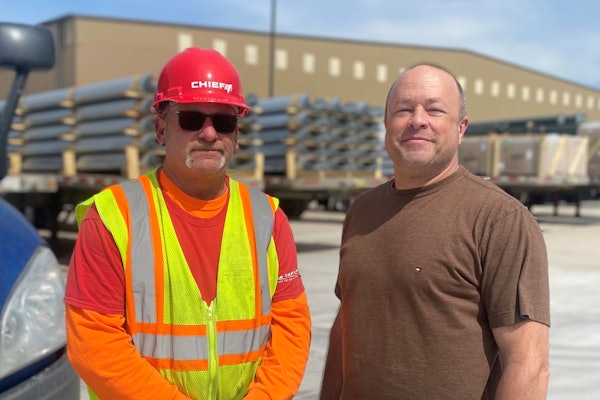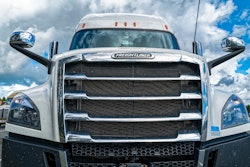It’s Friday afternoon and the entire computer system at Houff Transfer, a 165-truck Virginia carrier, is down. Grant Doyle, the company’s secretary and treasurer, frantically calls vendors, and a team of employees troubleshoots a problem that could have severe consequences.
“When the computer’s down, there’s just not enough hands to handle everything,” says Barry Ebling, director of safety and personnel. “We do everything on it. Dispatch is on it.
Qualcomm information comes through it. Now we’ve lost our communications with our drivers, and it’s Friday. The drivers are climbing the wall.”
Before long Houff’s employees discover the problem – a loose power cord that connects to the main AS/400 server dislodged when another piece of equipment was moved. It’s a simple problem, but one that threatened to paralyze the Weyers Cave, Va-based carrier.
“You get those days,” Ebling says. “This is one of them. It just happens to be a Friday.”
The day is critical because Houff brings most of its drivers back to their home terminals Friday night and Saturday morning. Drivers get a 48-hour weekend between Friday night and Monday morning and a lot of coordination goes into bringing in the fleet. Technology is great when it’s working, Doyle says. “When it’s not…”
Some better than others
Houff Transfer has invested in technology since the company bought its first computer in 1985, Doyle says. Houff’s most recent technological addition is a document imaging system, which has the potential to improve worker productivity.
The system, which pieces together a Kodak imaging system and a proprietary software system, allows Houff to scan its bills of lading, freight bills and other essential documents. Scanning reduces the amount of photocopying and filing employees have to perform.
“It has been successful,” Doyle says. “We’re now scanning all our delivery documents. That’s eliminating a lot of copying. When we bill our customers, we have to send photocopies of delivery bills, about 85 percent of shipments handled.”
The company is still essentially copying the bills, but now it’s able to store those copies in a computer database. The employee responsible for copying in the past no longer has to go to a file and pull the bill. Instead, the document can be retrieved from the system quickly If a bill is lost in the mail, for instance, all the documents are linked together in the computer and can be easily reprinted.
Doyle says the company invested between $60,000 and $65,000 in the robust system and the customized software, which interfaces with its TMW operations, support and accounting systems on Houff’s AS/400 platform. “We already had a billing system in place with our TMW software,” he says. “When we printed out a bill we would have to manually generate a photocopy at that point. Now documents come out right behind each other.”
That saves time stapling and organizing, but is it saving money? “That’s hard to determine,” Doyle says. “What it prevents is adding employees as you go down the road. You’re still copying, and you’re still printing. But now you’re not having to go to a file and copy. You just pull it up more quickly.
“We’re probably generating a third more bills per month than we were before and haven’t even skipped a beat,” Doyle says. Although growth has been stagnant this year, he expects Houff Transfer to expand in the future without having to increase its office staff. “Under the old system we wouldn’t be able to do that.”
While the scanning seems to be working out, Doyle is more skeptical about another technological investment – electronic data interchange – the company made to meet its clients’ needs. Although EDI is designed to save money and paperwork by standardizing forms and allowing them to be transmitted electronically, Doyle says his company hasn’t made EDI pay off.
In theory, EDI makes financial sense because trading partners like trucking companies and consignees can reduce paperwork and postage. The system also has the potential to reduce costly data entry errors and gives fleets that use EDI a marketing advantage over fleets that do not. But those advantages come with costs, including a per-character transmission charge similar to messaging on a satellite system.
“What’s so frustrating about it is EDI is supposed to have standards,” Doyle says. “Each client has different standards though. You can’t take a base product and use it for everybody. They all want to use it differently. EDI is basically a three-step process: load tendering, delivery confirmation and electronic invoicing. But many clients only want to use pieces of the puzzle, instead of the entire process.”
Because clients ask for so much information and because they also ask for different information, Houff bears a substantial upfront cost to implement each piece for each customer.
Another improvement promised by EDI is faster settlement of terms. Although Houff uses the system to confirm delivery faster, clients still delay payment until the last possible moment. “It’s costing us to satisfy our customer needs,” Doyle says. “I’m not certain it ever will pay off.”
Company Treasurer Grant Doyle recently oversaw the installation of a new document imaging system, one customized for the carrier by a local tech firm. With the new system, the company can process more bills per month without hiring additional staff.
Smart outsourcing and investing
For Houff, EDI is an example of how investing in technology can be risky. The company tries to limit that impact by closely researching its decisions. That’s been one of Doyle’s jobs since he joined the company in the 1980s. When Houff Transfer plans to purchase technology it studies the addition seriously, weighing what benefits it will bring against costs. “There are several of us that understand and discuss technology,” he says.
A major technological investment takes the same kind of intense research and experience as a major equipment purchase. From that first computer purchase, Houff Transfer developed a partnership with a company that understands information technology the way Houff understands trucking. The company, a local IT firm called RHD Financial Systems helps Houff evaluate and integrate new technology.
RHD has grown along with Houff and has a specialty in trucking. When it came to installing the new document scanning equipment, Houff’s tech partner was able to interface the new system seamlessly with existing software and systems. That kind of relationship has made purchasing technology and upgrading smoother for Houff Transfer, Doyle says.
Houff doesn’t buy every piece of new technology either. Even though the carrier likes to cater to its clients’ needs, sometimes the cost doesn’t justify the investment.
“We’ve looked at some trailer tracking devices that we haven’t thought justified the cost,” Doyle says. “When our clients demand something and it doesn’t fit, we tell them. We have said to one or two clients that we can’t add a certain technology for just one or two shipments a month. We haven’t totally neglected the client. It’s just we can’t do it for one shipment a month.”
Doyle says some clients have turned elsewhere to satisfy those needs and others have stayed with Houff. “It depends on what their corporate office is telling them,” he says.
Houff Transfer
Location: Weyer’s Cave, Va
Secretary/treasurer: Grant Doyle
Equipment: 135 International Eagles, Macks and GMC Whites, and 30 owner-operators. Detroit and Cummins engines; 9-Speed Road Ranger transmissions; 10-Speed Overdrive Eaton; 600 Wabash, Strick and Fruehauf dry vans
Challenge: Getting profitability out of technical upgrades
Solution: Research before you buy and partner with local IT company for help.
Time-proven practices
While Houff has embraced modern technology, the company also prides itself on its attention to low-tech business practices. The company performs maintenance on its trailers every time they come into the yard, washing them and repairing any problems. Trucks receive similar attention and are generally washed every weekend.
“Every unit that comes through our yard goes through our inspection facility every week,” Doyle says. He says the company performs the upkeep to keep its loads moving and to ensure its equipment is safe.
For the same reasons, Houff Transfer, which has operations at major port cities such as Baltimore, Richmond and Norfolk, Va., tries not to not pull containers over the road, opting to offload freight at one of its nearby terminals and then reloading into its own trailers. This practice means Houff drivers don’t have to handle battered container equipment, and the company avoids possible logistical problems.
“If you’re picking up a load at the ports and the freight is bound to West Virginia, you only have three days to get the container back,” says safety director Ebling. “That isn’t easy to do. Whereas when we have it on our trailer, we have it on our time frame.”
Houff’s range of operations isn’t broad. The company’s average length of haul is less than 220 miles, and it has significant pickup-and-delivery operations. Houff, which operates eight terminals in four states, runs only dry vans and hauls a mix of raw materials, like paper and finished products.
Houff’s mixture of short truckload hauls, terminal-to-terminal operations and local P&D helps the company resolve problems that nag at many carriers. Used truck disposal, for example, isn’t a problem. Houff buys its trucks new and runs and maintains them for nearly 1 million miles. The trucks are then retired to work at Houff’s terminals and its local P&D operations.
Nor is driver retention a problem. “Our turnover is less than 15 percent. The biggest reason is they’re short-haul drivers,” Ebling says. The short distances means Houff Transfer drivers are home for the weekend which helps retention, and the drivers still get about the same number of miles an over-the-road driver gets.
“They’re gone a week at a time,” Ebling says. “They always get a 48-hour weekend and they’re never gone more than 300 or 400 miles from home.”
Recruiting, however, is another story. Most young drivers, Ebling says, want to go over the road. Older drivers want to be home more. “Linehaul road drivers want to drive thousands of miles. Most of our guys will go 100 miles to Richmond and then on to Baltimore. They’ll all handle three to four loads on any given day.”
The operation relies heavily on technology in which Houff has invested to guarantee loads are easily coordinated and drivers get home for the weekend. When that system works perfectly, it really pays off, Doyle says. But when it doesn’t, the company is stretched to respond.
Because of the focus the company places on investigating technology, those events are rare. “For a carrier our size, I think we’ve progressed well from a technology standpoint,” Doyle says. “We have a pretty good format for success.”







